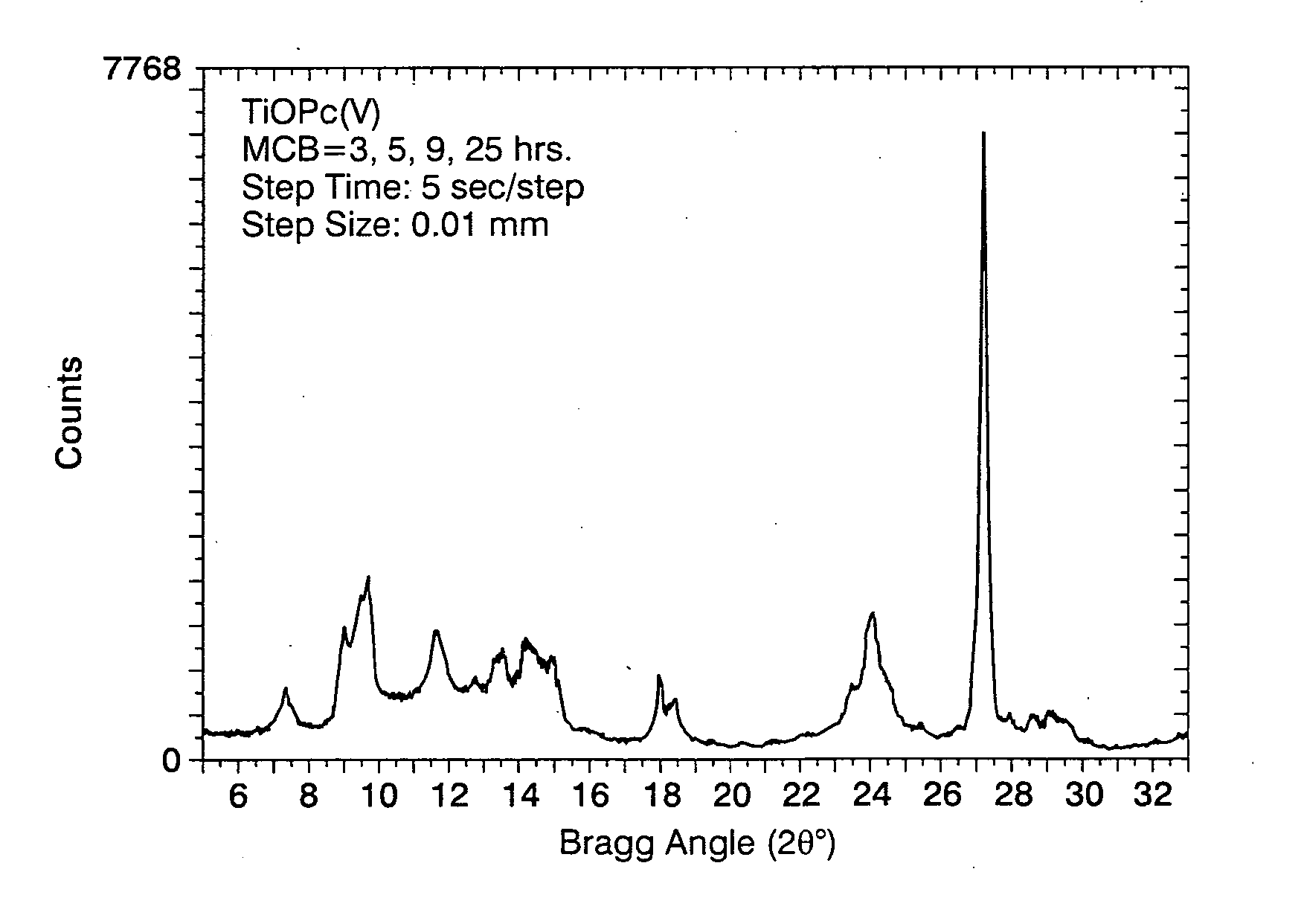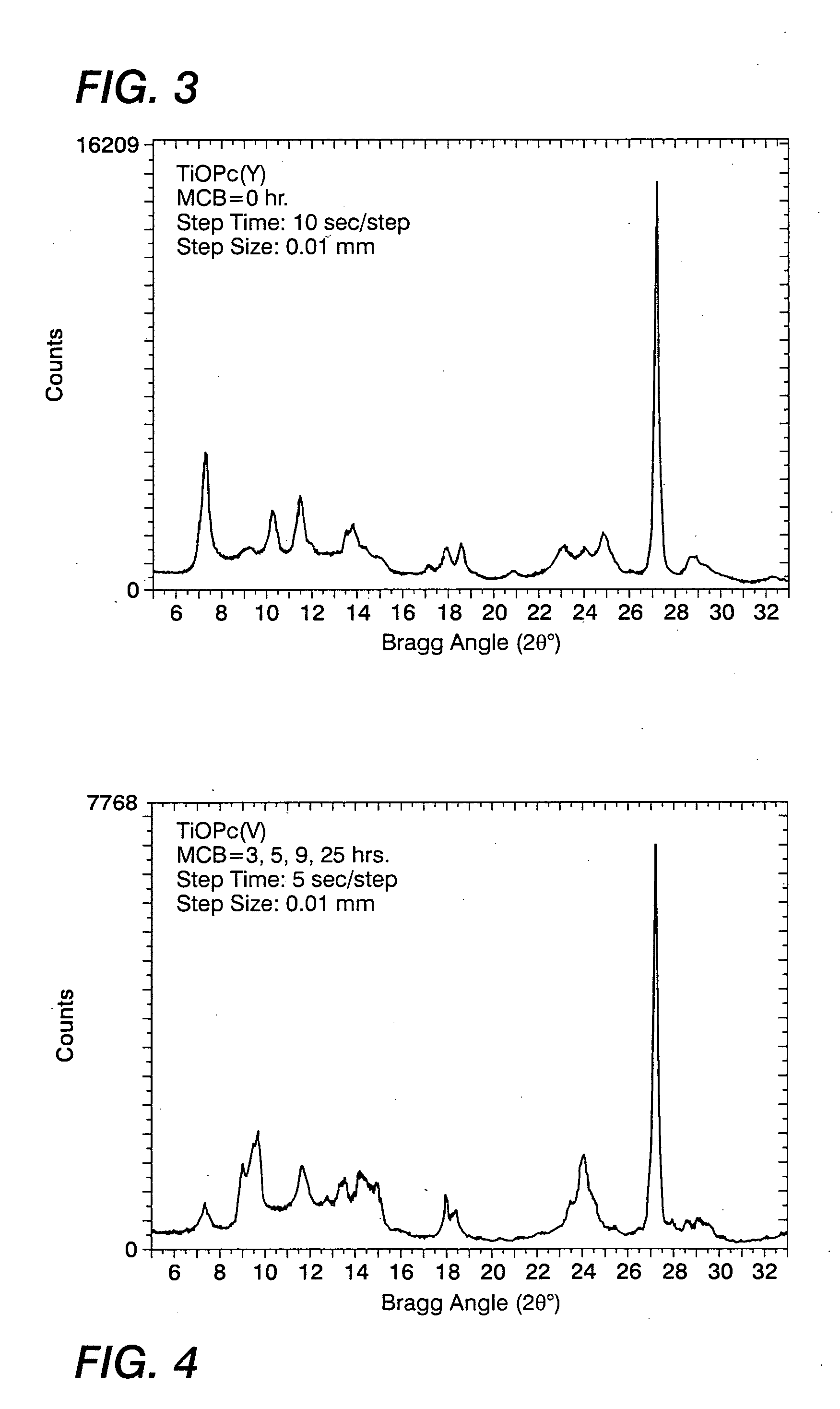Processes for the preparation of high sensitivity titanium phthalocyanines photogenerating pigments
a technology of titanium phthalocyanine and photogenerating pigment, which is applied in the field of preparation of high sensitivity titanyl phthalocyanine photogenerating pigment, can solve the problems of inability to meet the requirements of high-sensitivity titanium phthalocyanine pigment,
- Summary
- Abstract
- Description
- Claims
- Application Information
AI Technical Summary
Problems solved by technology
Method used
Image
Examples
example i
Preparation of Type I Titanyl Phthalocyanine
[0071] A Type I titanyl phthalocyanine was prepared as follows: To a 300 milliliter three-necked flask fitted with mechanical stirrer, condenser and thermometer maintained under an argon atmosphere was added 3.6 grams (0.025 mole) of 1,3-diiminoisoindoline, 9.6 grams (0.075 mole) of o-phthalonitrile, 75 milliliters (80 weight percent) of N-methylpyrrolidone and 7.11 grams (0.025 mole) of titanium tetrapropoxide (all obtained from Aldrich Chemical Company except phthalonitrile which was obtained from BASF). The resulting mixture (20 weight percent of solids) was stirred and warmed to reflux (about 198° C.) for 2 hours. The resultant black suspension was cooled to about 150° C. and then was filtered by suction through a 350 milliliter, M-porosity sintered glass funnel, which had been preheated with boiling dimethyl foramide (DMF). The solid Type I TiOPc product resulting was washed with two 150-milliliter portions of boiling DMF and the fil...
example ii
Preparation of Type V Titanyl Phthalocyanine
[0073] Fifty grams of TiOPc Type I were dissolved in 300 milliliters of a trifluoroacetic acid / methylene chloride (1 / 4, volume / volume) mixture for 1 hour in a 500-milliliter Erlenmeyer flask with magnetic stirrer. At the same time, 2600 milliliters of methanol / methylene chloride (1 / 1, volume / volume) quenching mixture was cooled with a dry ice bath for 1 hour in a 3000 milliliter beaker with magnetic stirrer, and the final temperature of the mixture was about −25° C. The TiOPc solution was transferred to a 500-milliliter addition funnel with a pressure-equalization arm, and added into the cold quenching mixture over a period of 0.30 minutes. The mixture was then allowed to stir for an additional 30 minutes. The mixture was hose-vacuum filtered through a 2000-milliliter Buchner funnel with fibrous glass frit of 4-8 μm in porosity. The pigment was then well mixed with 1500 milliliters of methanol in the funnel, and vacuum filtered. The pigme...
example iii
Preparation of a Type V Titanyl Phthalocyanine
[0075] Fifty grams of TiOPc Type I was dissolved in 300 milliliters of a trifluoroacetic acid / methylene chloride (1 / 4, volume / volume) mixture for 1 hour in a 500-milliliter Erlenmeyer flask with magnetic stirrer. At the same time, 2600 milliliters of a methanol / methylene chloride (3 / 1, volume / volume) quenching mixture was cooled with a dry ice bath for 1 hour in a 3000 milliliter beaker with magnetic stirrer, and the final temperature of the mixture was about −10° C. The TiOPc solution was transferred to a 500-milliliter addition funnel with a pressure-equalization arm, and added into the cold quenching mixture over a period of 60 minutes. The mixture was then allowed to stir for an additional 30 minutes. The mixture was hose-vacuum filtered through a 2000-milliliter Buchner funnel with a fibrous glass frit of 4-8 μm in porosity. The pigment was then well mixed with 1500 milliliters of methanol in the funnel and vacuum filtered. The pig...
PUM
 Login to View More
Login to View More Abstract
Description
Claims
Application Information
 Login to View More
Login to View More - R&D
- Intellectual Property
- Life Sciences
- Materials
- Tech Scout
- Unparalleled Data Quality
- Higher Quality Content
- 60% Fewer Hallucinations
Browse by: Latest US Patents, China's latest patents, Technical Efficacy Thesaurus, Application Domain, Technology Topic, Popular Technical Reports.
© 2025 PatSnap. All rights reserved.Legal|Privacy policy|Modern Slavery Act Transparency Statement|Sitemap|About US| Contact US: help@patsnap.com



